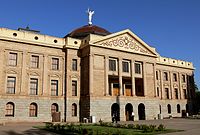James Riely Gordon
James Riely Gordon (August 2, 1863 – March 16, 1937) was an architect who practiced in San Antonio until 1902 and then in New York City, where he established a national reputation. J. Riely Gordon is best known for his landmark county courthouses, in particular those in Texas. Working during the state's "Golden Age" (1883-1898) of courthouse construction, Gordon saw 18 of his designs erected from 1885 to 1901; today 12 remain.Gordon was born in Winchester, Virginia, to George Muir and Sarah Virginia (Riely) Gordon. When he was 11 his family moved to San Antonio. At 16 he began working in the engineering office of the International and Great Northern Railroad.In 1882, Gordon apprenticed to W.K. Dodson of Waco (not to be confused with W.C. Dodson, himself a designer of courthouses). Soon after Gordon went to work for the Office of the Supervising Architect of the Treasury, the agency responsible for the design of federal court buildings, customs houses, post offices, etc. In 1887 he returned to San Antonio to supervise construction of that city's U.S. Post Office and Courthouse (replaced in 1937). Gordon was essentially self-educated in his art, learning on his jobs, but never attending a school of architecture.In 1891, Gordon and his then partner, D.E. Laub, won first prize of $1,000 in a country-wide competition to design the new Bexar County Courthouse; shortly afterwards they ended their partnership. The building met with popular acclaim.J. Riely Gordon's specialty while practicing in Texas was public buildings, though he also designed houses and commercial structures. He became a master of the Romanesque Revival style that had been introduced to great acclaim by Henry Hobson Richardson'>Henry Hobson Richardson with his Trinity Church in Boston in 1877. Returning to the roots of the style in the medieval Auvergne Region of France, Gordon is said to have "out-Richardsonianed Richardson" with his finest Romanesque work in Decatur and Waxahachie, Texas.Gordon's most successful plan—apparently his own unique design, without precedent—was that of a Greek cross with a square central atrium and stairwell, and quarter-circular entrance porches in each corner. This Signature Plan of his captured the passing breeze, which lifted thru the central atrium like a chimney, providing a natural ventilation system. Putting the entrances in the corners also shortened the hallways, saving space. He built 11 courthouses of this type in Texas between 1891 and 1900.His masterpiece is the Ellis County Courthouse in Waxahachie, which has become the icon of the town-square, late Victorian Era genre. The massive building tapers to 134 feet at the peak of the central clock tower, atop a vast roof punctuated by dormers. It took two million bricks, "160 car loads of Texas granite, 100 car loads of Pecos red sand stone, used in trimming the building, and 14 cars of iron". The pyramidal mass is softened by decorations such as carved faces of people and animals (apparently by the accomplished artisan Harry Herley) as well as multi-colored stones and bricks, and metal eagles perched on spirelets above the roof.After he won commissions for courthouses in Hazelhurst (Copiah County) and Woodville (Wilkenson County) in Mississippi, political shenanigans cheated Gordon out of a commission for that state's new capitol. Later Gordon fought hard to win the contract for a new City Hall in Vicksburg, then the state's largest city. Like his proposed design for the capitol, the luscious-looking city hall featured curving rows of columns. Gordon got some satisfaction from the crooked state politicians with this "graceful, dignified, and architecturally fine" building in Vicksburg that flaunts its Beaux-Arts beauty on a crest above the Mississippi River.Using his design for the Mississippi capitol, Gordon won the commission for the Arizona Territorial Capitol building in Phoenix, which became the state capitol when Arizona was admitted to the Union in 1912; today it is a museum. Another notable building was the award-winning Texas Pavilion at the 1893 World's Columbian Exposition in Chicago.In 1902, Gordon moved his practice to Dallas, and then in 1904 to New York. For a few years there he was in partnership with architects Evarts Tracy and Egerton Swartwout.Gordon designed a number of substantial buildings in Manhattan, but almost all of them have since been replaced by new structures. One venerable survivor from 1910, in the Gramercy Park area, is the apartment house 36 Gramercy Park East. With a soaring pair of stacked bay windows, it is clad in white terra cotta, like Cass Gilbert's Woolworth Building of the same period.While apartment houses and commercial buildings dominated Gordon's practice in New York City, he did see more courthouse work, in Somerville and Hackensack, NJ, in Oakland, MD, in Ebensburg, PA, and in Wampsville and Cortland, NY.The significance of his role in the New York area may be inferred from the fact that his obituary in the New York Times failed to even mention the word "Texas".
Personal facts

| Alias (AKA) | J. Gordon Riely J. Riely Gordon |
|---|---|
| Birth date | August 02, 1863 |
| Birth place | |
| Religion | |
| cause of death | |
| Date of death | March 16, 1937 |
| Place of death |